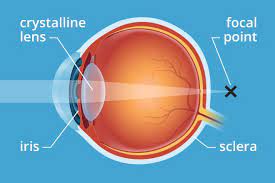 Presbyopia refers to the physiological insufficiency of accommodation associated with the aging of the eye.
Presbyopia refers to the physiological insufficiency of accommodation associated with the aging of the eye.
It results in progressively worsening ability to focus clearly on close objects.
Affects many adults over the age of 40.
Around 25% of people (1.8 billion globally) are currently affected.
Presbyopia symptoms include: difficulty reading small print which results in having to hold reading material farther away; headaches, and eyestrain.
Other types of refractive errors may coexist with presbyopia.
Presbyopia is similar to hypermetropia or far-sightedness which starts in childhood and exhibits similar symptoms of blur in the vision for close objects.
Symptoms: Difficulty reading small print, having to hold reading material farther away, headaches, eyestrain.
Progressively worsens in those over 40 years old.
Cause: Age-related hardening of the lens of the eye due to decreased elasticity and increased hardness, and ciliary muscle power of the eye, causing the eye to focus light behind rather than on the retina when looking at close objects.
With presbyopia there is lens hardening by decreasing levels of α-crystallin, a process which may be sped up by higher temperatures.
Lens hardening results in a near point greater than 25 cm or equivalently, less than 4 diopters).
Treatment:
Eyeglasses, contact lenses.
Frequency 25% of current population, but all eventually are affected.
Abnormal part of the aging process.
It is a type of refractive error along with nearsightedness, farsightedness, and astigmatism.
Diagnosis is by an eye examination.
Presbyopia can be corrected using glasses, contact lenses, multifocal intraocular lenses, or LASIK surgery.
The most common treatment is glass correction using convex lens.
Glasses used to correct presbyopia may be simple reading glasses, bifocals, trifocals, or progressive lens.
The first symptoms noted: difficulty reading fine print, particularly in low light conditions, eyestrain when reading for long periods, blurring of near objects or temporarily blurred vision when changing the viewing distance.
Many complain that their arms have become too short to hold reading material at a comfortable distance.
Presbyopia imperfections, become less noticeable in bright sunlight when the pupil becomes smaller.
The onset of presbyopia varies among certain professions and those with miotic pupils.
Farmers and homemakers seek correction later, whereas service workers and construction workers seek correction earlier.
Many people with near-sightedness can read comfortably without eyeglasses or contact lenses even after age forty.
Surgery can create a reading eye and a distance vision eye, a technique commonly used in contact lens practice, known as monovision.
The eye’s near point, is the closest point at which an object can be brought into focus by the eye.
A standard near point distance of 25 cm is assumed in the design of optical instruments, and in characterizing optical devices such as magnifying glasses.
The lens is suspended by a membrane, the zonula, which holds it under tension, and its tension is released, by contraction of the ciliary muscle, to allow the lens to become more round, for close vision.
The ciliary muscle, which is outside the zonula, must be circumferential, contracting like a sphincter, to slacken the tension of the zonula pulling outwards on the lens.
The eyes seem to be in a relaxed state when focusing at infinity, and explains why no amount of effort seems to enable a myopic person to see farther away.
The ability to focus on near objects declines throughout life.
To overcome presbyopia, two main components of the visual system can be addressed: image capturing by the optical system of the eye and image processing in the brain.
Image capturing in the eye by correction options.
Corrective lenses provide vision correction over a range as high as +4.0 diopters.
A convex lens for reading glasses is required for presbyopia specialized preparations and requires the services of an optometrist.
Contact lenses can also be used to correct the focusing loss that comes along with presbyopia.
Multifocal contact lenses can be used to correct vision for both the near and the far.
Choosing contact lenses to correct one eye for near and one eye for far with a method called monovision.
Refractive surgery creates multifocal corneas.
PresbyLASIK, a type of multifocal corneal ablation LASIK procedure may be used to correct presbyopia.
Results are variable and some people have a decrease in visual acuity.
Studies claim improvements in near visual acuity by the use of training protocols based on perceptual learning and requiring the detection of briefly presented low-contrast Gabor stimuli.
